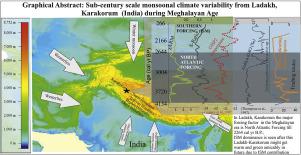当前位置:
X-MOL 学术
›
Palaeogeogr. Palaeoclimatol. Palaeoecol.
›
论文详情
Our official English website, www.x-mol.net, welcomes your feedback! (Note: you will need to create a separate account there.)
Reconstructing climate variability during the last four millennia from trans-Himalaya (Ladakh-Karakoram, India) using multiple proxies
Palaeogeography, Palaeoclimatology, Palaeoecology ( IF 3 ) Pub Date : 2021-01-01 , DOI: 10.1016/j.palaeo.2020.110142 Binita Phartiyal , Randheer Singh , Debarati Nag , Anupam Sharma , Rajesh Agnihotri , Vandana Prasad , Tandong Yao , PingYao , Balasubramanian Karthick , Priyanka Joshi , Sanjay K.S. Gahlaud , Biswajeet Thakur
Palaeogeography, Palaeoclimatology, Palaeoecology ( IF 3 ) Pub Date : 2021-01-01 , DOI: 10.1016/j.palaeo.2020.110142 Binita Phartiyal , Randheer Singh , Debarati Nag , Anupam Sharma , Rajesh Agnihotri , Vandana Prasad , Tandong Yao , PingYao , Balasubramanian Karthick , Priyanka Joshi , Sanjay K.S. Gahlaud , Biswajeet Thakur

|
Abstract In this communication we reconstruct climate variability of Ladakh, Trans-Himalaya region, on sub-century timescale spanning the last four millennia (~4130 to 260 cal yr ‘before present’ (BP)). To achieve this objective, we measured a suite of physical, biotic and inorganic proxies of a lacustrine sequence. In general, between ~4130 to ~2640 cal yr BP proxy records reveal climate variability following a typical pattern of the northern hemispheric climate and appear to be dominated by westerlies. Thereafter, the Indian Summer Monsoon (ISM) forcing appears to dominate regional climate. The former period appears to have experienced human presence as evidenced by an invasive species of diatom –Didymosphenia and charcoal, likely originating from human activities on trading routes with Central Asia, China and Tibet. After ~2640 cal yr BP, when ISM started governing the climate of the Ladakh- Karakoram region, it probably induced high-frequency climate variability leading to disasters related to landslides, debris flows, avalanches etc., eventually reducing the intra-boundary trade. A similar situation appears to be gripping the region again as meteorologically recorded precipitation data from Ladakh reveals arrival of high-frequency monsoonal variability in the region with recurrent flash floods (e.g., 2010, 2013).
更新日期:2021-01-01



























 京公网安备 11010802027423号
京公网安备 11010802027423号